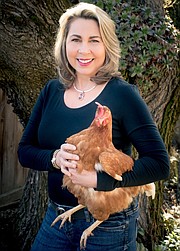Master Gardener: Preventing disease in the garden
Simple Steps to Prevent Disease in the Garden
Just about every gardener has experienced some type of disease in their garden. Whether it’s early blight on tomatoes, mosaic virus on cucumbers or powdery mildew on peas, it’s bound to happen.
It doesn’t mean you’ve failed as a gardener — it’s just part of gardening — and it’s a great learning opportunity. What caused the disease? What could be done to prevent it? Is there a cure?
The reality is that it is far easier to prevent disease in the garden than it is to try and cure or eliminate it. In fact, many common garden diseases don’t have a cure — so prevention is the key.
One way to prevent disease is to select and grow plant varieties that are resistant to specific diseases. Many hybrid vegetable varieties are bred for disease resistance and you’ll find that information in the plant’s description or tag.
You may have noticed the letters “A” or “VF” on tomato plant tags — this signifies the variety is resistant to Alternaria (early blight) or Fusarium Wilt and Verticillium Wilt. Keep in mind that disease-resistant does not mean disease-proof.
The good news is that many diseases can be prevented by simply following a few basic gardening best practices:
• Always water at the base of the plant and avoid overhead watering. Wet foliage is a welcoming environment for many pathogens including early blight and powdery mildew. If foliage is wet from rain or even morning dew, avoid handling the plants.
• Water in the morning hours to allow foliage to dry during the day and reduce disease risk.
• Mulch around the base of plants. This helps prevent soil-borne diseases like early blight and other fungal diseases where pathogen spores in the soil can make contact with leaves. This also helps keep plant roots cool and conserves moisture.
• Avoid cultivating around or disturbing plant roots. Bacterial diseases need an entrance point into the plant. Roots damaged from cultivation can provide an access for pathogens.
• Follow plant spacing recommendations. Crowding plants limits air circulation and becomes a haven for foliar diseases like powdery mildew. Crowded plants also easily spread disease to other plants.
• Prune suckers and crossing stems for good airflow and to remove any leaves or stems that touch the soil. Proper pruning can help prevent the spread of soil-borne and foliar diseases.
• Practice crop rotation and avoid planting the same vegetable or vegetable family in the same location year after year. This is very important to prevent the buildup of soil-borne diseases and to avoid insect infestations.
• Practice good sanitation by spraying pruners and snips with rubbing alcohol after removing any diseased plant material. Wash your hands — you can spread disease too! And finally, tidy-up and place diseased plant debris in the trash and not the compost bin.
Diagnosing plant diseases can be challenging — even for experts. Many diseases exhibit similar conditions, such as leaf spotting and yellowing or browning leaves.
My advice is this: if your once-healthy plants begin to show signs of disease, take photos and collect a sample of the affected leaf, stem or fruit and visit the Idaho Master Gardener’s Plant Clinic. Certified master gardeners can help identify the problem and offer various methods for prevention and control. This is a free resource that will save you time, money and worry.
• • •
Candace Godwin is a certified Idaho master gardener. The University of Idaho Extension, Kootenai County Idaho Master Gardener program is located in the UI Research Park, 958 S. Lochsa St., in Post Falls. Learn more about us at https://www.uidaho.edu/extension/county/kootenai/garden or on Facebook. Visit us in person, email us at kootenaimg@uidaho.edu, or call us at 208-292-2525. IMG services are free to the public.









